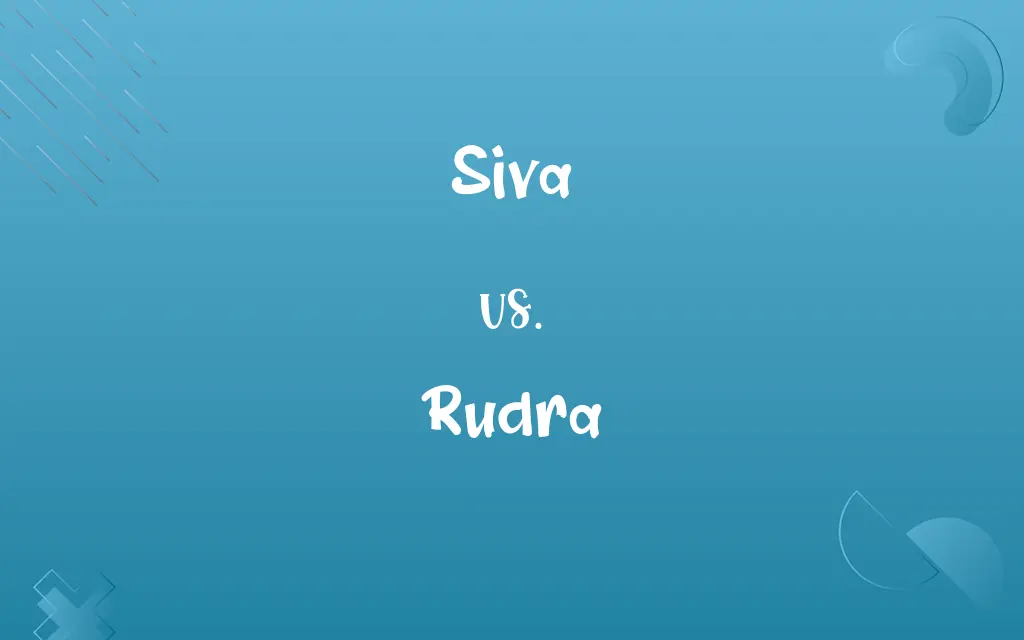Siva vs. Rudra: Know the Difference

By Shumaila Saeed || Published on February 26, 2024
Siva, or Shiva, is a major Hindu deity symbolizing creation and destruction, while Rudra is an ancient Vedic deity, a fierce aspect of Shiva associated with storms and hunting.

Key Differences
Siva, commonly known as Shiva, is one of the principal deities of Hinduism, embodying the roles of creator, preserver, and destroyer. Rudra, in early Vedic texts, is depicted as a fierce and destructive deity, often associated with storms, wind, and hunting.
Shumaila Saeed
Feb 26, 2024
In Hindu mythology, Siva is part of the Trimurti, along with Brahma and Vishnu, and is revered for his powers of transformation and regeneration. Rudra, on the other hand, is considered an earlier form or aspect of Siva, known for his wrathful and turbulent nature.
Shumaila Saeed
Feb 26, 2024
Siva is widely worshipped in various forms and representations, notably the Shiva Linga, symbolizing his all-encompassing nature. Rudra, while still a form of Siva, is less commonly worshipped independently, and his representations are often linked to wild and fierce attributes.
Shumaila Saeed
Feb 26, 2024
The concept of Siva encompasses a duality of gentleness and fierceness, with his benevolent aspects balanced by the destructive powers. Rudra, in contrast, predominantly represents the untamed and destructive force, often invoked for his power and ferocity.
Shumaila Saeed
Feb 26, 2024
Over time, Siva’s representation in Hinduism has evolved to include a complex character with philosophical depth and spiritual significance. Rudra, while integral to the understanding of Siva, remains more focused on the primal, powerful aspects of the divine.
Shumaila Saeed
Feb 26, 2024
ADVERTISEMENT
Comparison Chart
Role in Hinduism
Creator, preserver, destroyer
Fierce aspect of Siva, storm god
Shumaila Saeed
Feb 26, 2024
Worship and Representation
Widely worshipped, Shiva Linga, many forms
Less commonly worshipped, associated with fierceness
Shumaila Saeed
Feb 26, 2024
Attributes
Duality of gentleness and destructiveness
Primarily fierce and destructive
Shumaila Saeed
Feb 26, 2024
Evolution in Hindu Mythology
Evolved to a complex, spiritual figure
Remains a symbol of primal power
Shumaila Saeed
Feb 26, 2024
Relationship in Hindu Pantheon
Part of the Trimurti, central deity
Considered an early form or aspect of Siva
Shumaila Saeed
Feb 26, 2024
ADVERTISEMENT
Siva and Rudra Definitions
Siva
A principal Hindu deity symbolizing the cycle of creation and destruction.
Devotees visit the temple to offer prayers to Siva during the festival of Maha Shivaratri.
Shumaila Saeed
Jan 19, 2024
Rudra
An ancient Vedic deity, Rudra is known for his fierce and stormy nature.
Rudra is often invoked in ancient texts for his power over storms and wind.
Shumaila Saeed
Jan 19, 2024
Siva
Siva is known for his meditative nature and association with the sacred Mount Kailash.
Siva is often depicted in art as meditating on Mount Kailash.
Shumaila Saeed
Jan 19, 2024
Rudra
Rudra is a precursor to the more complex deity Siva in later Hinduism.
Rudra's evolution into Siva marks the transition from Vedic to Puranic Hinduism.
Shumaila Saeed
Jan 19, 2024
Siva
Siva is part of the Hindu Trimurti, along with Brahma and Vishnu.
In Hindu mythology, Siva's role in the Trimurti is to destroy the world in order to recreate it.
Shumaila Saeed
Jan 19, 2024
ADVERTISEMENT
Rudra
Rudra represents the destructive and fearsome aspect of the divine.
Rudra’s ferocity is seen as a necessary force in maintaining cosmic balance.
Shumaila Saeed
Jan 19, 2024
Siva
Siva is revered for his role as the destroyer, bringing necessary change and renewal.
Siva’s destruction is viewed not as negative but as a vital part of the cycle of existence.
Shumaila Saeed
Jan 19, 2024
Rudra
Rudra, an aspect of Siva, symbolizes the wild and untamed forces of nature.
In Vedic hymns, Rudra is described as the howler, reflecting his stormy character.
Shumaila Saeed
Jan 19, 2024
Siva
As Nataraja, Siva represents the cosmic dance of creation and destruction.
The statue of Siva as Nataraja symbolizes the eternal rhythm of the universe.
Shumaila Saeed
Jan 19, 2024
Rudra
Rudra is associated with hunting, known for his archery and prowess.
Ancient scriptures depict Rudra as a skillful hunter with a mighty bow.
Shumaila Saeed
Jan 19, 2024
Rudra
Father of the storm gods Marut; controller of nature; sometimes identified with Siva
Shumaila Saeed
Jan 17, 2024
Siva
One of the triad of Hindoo gods. He is the avenger or destroyer, and in modern worship symbolizes the reproductive power of nature.
Shumaila Saeed
Jan 17, 2024
Siva
The Destroyer; one of the three major divinities in the later Hindu pantheon
Shumaila Saeed
Jan 17, 2024
Repeatedly Asked Queries
What does Rudra symbolize?
Rudra symbolizes the untamed, fierce forces of nature and destruction.
Shumaila Saeed
Feb 26, 2024
Who is Siva in Hindu mythology?
Siva is a major deity representing creation, preservation, and destruction.
Shumaila Saeed
Feb 26, 2024
Who is Rudra in Hindu mythology?
Rudra is an ancient Vedic deity, representing storms and the fierce aspect of Siva.
Shumaila Saeed
Feb 26, 2024
Is Rudra part of the Trimurti?
No, Rudra is not part of the Trimurti but is an aspect of Siva.
Shumaila Saeed
Feb 26, 2024
How is Siva worshipped?
Siva is worshipped in many forms, including the Shiva Linga and Nataraja.
Shumaila Saeed
Feb 26, 2024
Are Siva and Rudra the same deity?
Rudra is an aspect of Siva, representing his fierce and destructive side.
Shumaila Saeed
Feb 26, 2024
What is the meaning of Siva's third eye?
Siva's third eye symbolizes spiritual wisdom and power.
Shumaila Saeed
Feb 26, 2024
What is the significance of Siva's Nataraja form?
Nataraja represents Siva's cosmic dance of creation and destruction.
Shumaila Saeed
Feb 26, 2024
What does Siva symbolize?
Siva symbolizes the cycle of life, encompassing creation, sustenance, and destruction.
Shumaila Saeed
Feb 26, 2024
What is Siva's role in the Trimurti?
In the Trimurti, Siva is the destroyer, complementing Brahma and Vishnu's roles.
Shumaila Saeed
Feb 26, 2024
Does Rudra have a family in mythology?
In some texts, Rudra is associated with a family, including his consort and children.
Shumaila Saeed
Feb 26, 2024
How is Rudra worshipped?
Rudra is worshipped in specific Vedic rituals and is revered for his fierce nature.
Shumaila Saeed
Feb 26, 2024
How does Siva relate to yoga and meditation?
Siva is often seen as the patron god of yoga and meditation.
Shumaila Saeed
Feb 26, 2024
What role does Rudra play in Vedic rituals?
Rudra is invoked in Vedic rituals for protection and to harness his fierce energy.
Shumaila Saeed
Feb 26, 2024
Does Rudra have a benevolent aspect?
While primarily fierce, Rudra also has aspects of a healer and protector.
Shumaila Saeed
Feb 26, 2024
How do Siva and Rudra differ in Hindu worship?
Siva is a central deity with diverse forms of worship, while Rudra is more specifically revered for his fierceness.
Shumaila Saeed
Feb 26, 2024
What are the legends associated with Siva's Mount Kailash?
Mount Kailash is considered Siva's abode, a place of spiritual significance.
Shumaila Saeed
Feb 26, 2024
Is Rudra associated with any natural phenomena?
Yes, Rudra is associated with storms, wind, and hunting.
Shumaila Saeed
Feb 26, 2024
What is a common symbol for Siva worship?
The Shiva Linga is a common symbol in Siva worship.
Shumaila Saeed
Feb 26, 2024
Is Rudra often depicted with a bow?
Yes, Rudra is often depicted as an archer, symbolizing his hunting prowess.
Shumaila Saeed
Feb 26, 2024
Share this page
Link for your blog / website
HTML
Link to share via messenger
About Author
Written by
Shumaila SaeedShumaila Saeed, an expert content creator with 6 years of experience, specializes in distilling complex topics into easily digestible comparisons, shining a light on the nuances that both inform and educate readers with clarity and accuracy.








































































